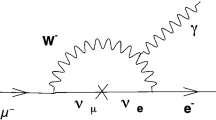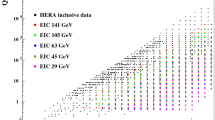Abstract
Low-energy neutral-current couplings arising in the Standard Model of electroweak interactions can be constrained in lepton scattering off hydrogen or a nuclear fixed target. Recent polarized electron scattering experiments at Jefferson Lab (JLab) have improved the precision in the parity-violating types of effective couplings. On the other hand, the only known way to access the parity-conserving counterparts is to compare scattering cross sections between a lepton and an anti-lepton beam. We review the current knowledge of both types of couplings and how to constrain them. We also present exploratory calculations for a possible measurement of \(g_{AA}^{eq}\) using the planned SoLID spectrometer combined with a possible positron beam at JLab.





Similar content being viewed by others
Data Availability Statement
This manuscript has no associated data or the data will not be deposited. [Authors’ comment: What presented here are not data from real experiments, but rather simulated uncertainties on the asymmetry.]
References
P. A. Zyla et al. (Particle Data Group), Prog. Theor. Exp. Phys. 2020, 083C01 (2020) https://doi.org/10.1093/ptep/ptaa104
J. Erler, S. Su, Prog. Part. Nucl. Phys. 71, 119 (2013). https://doi.org/10.1016/j.ppnp.2013.03.004. arXiv:1303.5522 [hep-ph]
J. Erler, C.J. Horowitz, S. Mantry, P. Souder, Ann. Rev. Nucl. Part. Sci. 64, 269 (2014). https://doi.org/10.1146/annurev-nucl-102313-025520. arXiv:1401.6199 [hep-ph]
C.S. Wood et al., Science 275, 1759 (1997). https://doi.org/10.1126/science.275.5307.1759
J. Guena, M. Lintz, M.A. Bouchiat, Mod. Phys. Lett. A 20, 375 (2005). https://doi.org/10.1142/S0217732305016853. arXiv:physics/0503143 [physics]
D. Androić et al. (Qweak Collaboration), Phys. Rev. Lett. 111, 141803 (2013) https://doi.org/10.1103/PhysRevLett.111.141803arXiv:1307.5275 [nucl-ex]
D. Androić et al. (Qweak Collaboration), Nature 557, 207 (2018) https://doi.org/10.1038/s41586-018-0096-0arXiv:1905.08283 [nucl-ex]
C.Y. Prescott et al., Phys. Lett. B 77, 347 (1978). https://doi.org/10.1016/0370-2693(78)90722-0
C.Y. Prescott et al., Phys. Lett. B 84, 524 (1979). https://doi.org/10.1016/0370-2693(79)91253-X
D. Wang et al. (PVDIS Collaboration), Nature 506, 67 (2014) https://doi.org/10.1038/nature12964
D. Wang et al. (PVDIS Collaboration), Phys. Rev. C 91, 045506 (2015) https://doi.org/10.1103/PhysRevC.91.045506arXiv:1411.3200 [nucl-ex]
G. Toh et al., Phys. Rev. Lett. 123, 073002 (2019). https://doi.org/10.1103/PhysRevLett.123.073002. arXiv:1905.02768 [physics.atom-ph]
D. Becker et al. (P2 Collaboration), Eur. Phys. J. A 54, 208 (2018) https://doi.org/10.1140/epja/i2018-12611-6arXiv:1802.04759 [nucl-ex]
J. P. Chen et al. (SoLID Collaboration) arXiv:1409.7741 [nucl-ex]
A. Argento et al., Phys. Lett. B 120, 245 (1983). https://doi.org/10.1016/0370-2693(83)90665-2
J. Erler, M.J. Ramsey-Musolf, Prog. Part. Nucl. Phys. 54, 351 (2005). https://doi.org/10.1016/j.ppnp.2004.08.001. arXiv:hep-ph/0404291 [hep-ph]
H. Spiesberger, preprint DESY–89–175
S.M. Berman, J.R. Primack, Phys. Rev. D 9, 2171 (1974). https://doi.org/10.1103/PhysRevD.9.2171
L. S. Cardman, AIP Conf. Proc. 1970, no.1, 050001 (2018). https://doi.org/10.1063/1.5040220
SoLID Collaboration (2019) https://hallaweb.jlab.org/12GeV/SoLID/files/solid-precdr-Nov2019.pdf
L.A. Harland-Lang, A.D. Martin, P. Motylinski, R.S. Thorne, Eur. Phys. J. C 75, 204 (2015). https://doi.org/10.1140/epjc/s10052-015-3397-6. arXiv:1412.3989 [hep-ph]
T.J. Hou et al., Phys. Rev. D 103, 014013 (2021). https://doi.org/10.1103/PhysRevD.103.014013. arXiv:1912.10053 [hep-ph]
Acknowledgements
X.Z. was supported by the U.S. Department of Energy (DOE) Early Career Award SC00–03885 during the early stage of this work, and currently by the U.S. DOE under Award number DE–SC0014434. The work of J.E. and H.S. is supported by the German-Mexican research collaboration grant SP 778/4–1 (DFG) and 278017 (CONACyT).
Author information
Authors and Affiliations
Corresponding author
Additional information
Communicated by Nicolas Alamanos
Appendix A: Neutral-current DIS asymmetries
Appendix A: Neutral-current DIS asymmetries
In this appendix, we derive asymmetries of lepton deep inelastic scattering off a nuclear target arising from the interference between electromagnetic and weak neutral current (NC) interactions. We are interested in the case of relatively small momentum transfer.
1.1 Neutral-current weak interaction Lagrangian
The kinematics of lepton-quark scattering is illustrated in Fig. 6, where the photon-fermion vertex is given by \(-ie\gamma ^\mu Q_f\) with \(Q_f\) the fermion electric charge in units of \(e=\sqrt{4\pi \alpha }\). Likewise, the Z-fermion vertex reads,
The matrix element for NC eq scattering can now be written,
where \(M_Z\) is the Z boson mass, and \(l_{i,f}\) and \(q_{i,f}\) are the Dirac spinors for the initial and final state electrons and quarks, respectively. At the SM tree level, the gauge coupling g is related to \(G_F\),
so that for small momentum transfer, \(\vert q^2\vert \ll M_Z^2\), and dropping the vector-vector interactions, the amplitude in Eq. (A.2) derives from the neutral-current weak interaction Lagrangian
where we used the same symbols for Dirac spinor fields and coefficient functions.
1.2 One-photon exchange amplitude and Z–\(\gamma ^*\) interference
For incoming leptons with helicity h (the case of anti-leptons will be treated separately), we have the one-photon exchange amplitude,
where,
is the projection operator for right-handed (\(h = +1\)) and left-handed (\(h = -1\)) leptons. The cross section of the electromagnetic process is,
For the weak neutral current interaction we have,
so that the interference term is given by,
Averaging over initial and summing over the final spin states,
Likewise, denoting the anti-lepton coefficient functions by \(v_{i,f}\), for incoming anti-leptons with helicity h the leptonic currents in Eqs. (A.5) and (A.8) are now \((\bar{v}_iP_h\gamma ^\mu v_f)\) and \(\left[ {\bar{v}}_iP_h \gamma ^\mu \left( g_V^l-g_A^l\gamma ^5\right) v_f\right] \), respectively. Eq. (A.10) then also applies for anti-leptons as long as one substitutes \(h\rightarrow -h\) and \(g_A^q\rightarrow -g_A^q\).
For anti-quarks at the \(\gamma \) or Z vertex one substitutes analogously the quark-coefficient functions by those of anti-quarks, with the result that Eq. (A.10) applies when one replaces \(g_A^q\rightarrow -g_A^q\) in the case of lepton scattering. Finally, for anti-lepton scattering off anti-quarks one needs to substitute \(h\rightarrow -h\) in Eq. (A.10).
1.3 Electroweak neutral current cross section asymmetries
In DIS one has to combine the scattering cross sections for all quarks in the target with weights according to the PDFs. From the definition in Eq. (9) we have,
If we now use the previous results, inserting the Mandelstam variables neglecting lepton and quark masses, i.e., \(s \equiv (k+P)^2 = 2 kP = 2 k'P'\) with \(P_\mathrm{quark} = x P_\mathrm{nucleon}\), and likewise \(u \equiv (k-P')^2 = -2 kP' = -2 k'P= -(1-y) s\),
where \(\lambda \) is the beam polarization and \(q(x,Q^2)\) are PDFs. The value \(Q_l=-1\) for electron scattering, \(Q^2 \equiv -q^2\), and the definitions of \(g_{AV}^{eq}\) and \(g_{VA}^{eq}\) were also used. We note that for the antiquark contributions the couplings \(g_A^q\) (and therefore all \(g_{VA}^{eq}\)) appear with an extra minus sign. For a proton target we obtain,
where we have further abbreviated \(U^+ \equiv u^+ + c^+\) and \(D^+ \equiv d^+ + s^+\), and have assumed \(c={\bar{c}}\) and \(s={\bar{s}}\) (and thus \(c_V=s_V=0\)). The function Y is defined in Eq. (14) and we will omit its dependence on y hereafter. For deuterium or other isoscalar targets (ignoring nuclear effects), we substitute \(u\rightarrow u+d\) and \(d\rightarrow u+d\) in the expression for \(A^{e^-}_{RL,p}\) above, and assume that c and s are the same in the proton and the neutron:
Ignoring the heavier s and c quarks, these expressions simplify further,
We now turn to the calculation of \(A^{e^+e^-}_{RL}\),
where the approximation is valid for \(Q^2 \ll M_Z^2\). For a nuclear target,
and likewise,
By substituting \(\vert \lambda \vert \rightarrow -\vert \lambda \vert \) one can obtain \(A^{e^+e^-}_{LR}\) from Eq. (A.18), and \(A^{e^+e^-}_{LL}\) from Eq. (A.19). For \(A^{e^+e^-}\) one can use (A.18) or (A.19) and set \(\vert \lambda \vert =0\). For the proton,
and for the deuteron,
Finally, if only u and d quarks are included,
and
The asymmetry measured at CERN on \(^{12}\)C was,
while for SoLID we can use unpolarized beams to allow for higher intensities and measure on the deuteron,
Rights and permissions
About this article
Cite this article
Zheng, X., Erler, J., Liu, Q. et al. Accessing weak neutral-current coupling \(g_{AA}^{eq}\) using positron and electron beams at Jefferson Lab. Eur. Phys. J. A 57, 173 (2021). https://doi.org/10.1140/epja/s10050-021-00490-z
Received:
Accepted:
Published:
DOI: https://doi.org/10.1140/epja/s10050-021-00490-z





